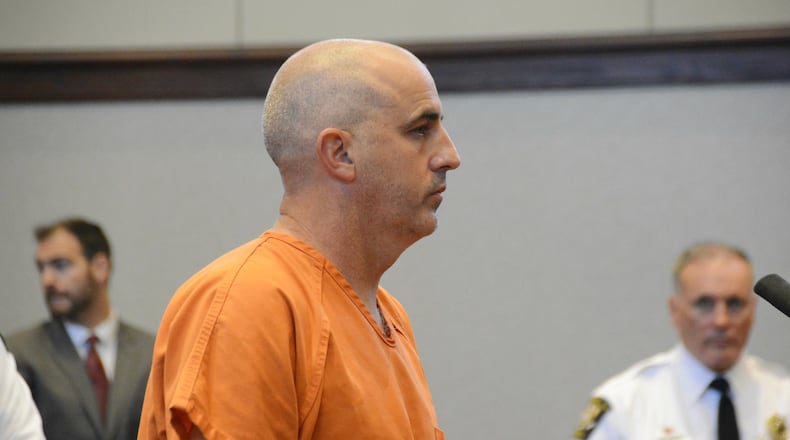The Ohio Department of Education investigated a record number of educators for possible misconduct last year that led to 553 of them facing some degree of discipline, including losing their license, according to the Office of Professional Conduct. The state board imposed disciplinary action in 127 cases, and 96 actions resulted in permanent revocations and permanent denials, the most severe penalties, according to the 2016 Educator Conduct Report reviewed by this news outlet.
Butler County Prosecutor Michael Gmoser said his office typically handles two cases a year involving students and teachers.
“They do seem to come in spurts,” he said.
In Middletown Schools, an investigation into a teacher began late last month when the high school’s resource officer was told by school administrators that a student wanted to report possible inappropriate behavior by a teacher.
That teacher resigned for “personal and professional reasons” days after the investigation began, according to the district, but Middletown Police Lt. Scott Reeve said there may be additional victims.
That case is scheduled to be presented to a Butler County grand jury for consideration of criminal charges in the next few weeks, Reeve said.
Last week, Harden, 43, of Liberty Twp., entered a guilty plea to one count of sexual battery, a third-degree felony. Harden entered the plea on a bill of information, bypassing the preliminary hearing and grand jury process. Police say he confessed to having sex with a female student at her home. Butler County Common Pleas Judge Greg Howard set sentencing for Dec. 20. Harden faces up to 20 months in jail.
Gmoser said the police investigation of the accused Hamilton Schools teacher was reviewed by his office’s sexual assault task force and it deemed criminal charges were not warranted because there was “insufficient evidence.”
According to the Oct. 23 police report obtained by this news outlet, the police investigation involved possible sexual imposition.
“Victims advise over the last several weeks the suspect had touched them in ways on their body that made them feel uncomfortable,” a Hamilton officer wrote in his report.
Now, the district “will be reviewing this personnel matter internally,” school officials said in a statement.
Gmoser said social media can make investigations more complicated.
“There is sometimes a resistance from adults and the child who don’t want to be dragged through the mud in a trial,” Gmoser said. “With social media and the Internet, they know the coverage will be all over the place. That sometimes makes them resistant to come forward.”
The young age of the victim can also lead to difficulties because they may not tell the whole truth at the beginning, Gmoser said. That can be argued by the defense at trial, he said.
“Peer pressure for the teen victim is monumental, combine that with immaturity, sometimes it can been challenging to get the story straight at the beginning,” Gmoser said.
These cases also are sometimes not reported directly to police officers or prosecutors, he said.
“School officials are not police officials,” Gmoser said. “Police officers know how to handle these cases and allegations.”
Technology also plays a part in gathering evidence, especially text messages between teachers and students.
“They aren’t just passing a note,” Reeve said. “And we can get access to phones.”
After receiving a referral from any number of sources — including school districts, residents, media reports, and prosecutors — the state evaluates each complaint to determine whether a more in-depth investigation is warranted. Nearly 11 percent of the referrals are investigated each year. There were 1,361 investigations last year, 439 more than in 2015.
In 2016, the state investigated 815 cases of educators having “conduct unbecoming” and 365 for criminal-miscellaneous offenses, 230 for theft offenses, 198 for violent offenses and 35 for sex offenses.
By law, ODE cannot comment on ongoing cases, said Brittany Halpin, associate director for media relations for the ODE. She said the ODE can’t confirm or deny the existence of ongoing cases, so it’s nearly impossible to know where a specific case might be in the system unless disciplinary action is posted.
The State Board does not impose disciplinary action if an allegation is discovered to be false, if the evidence is insufficient or if the proven conduct is of such a “minor degree” that it doesn’t constitute misconduct.
To reduce the possibility of teachers who lost their licenses moving to a different state, in hopes of escaping their inappropriate behavior, nearly every state education agency provides a system that parents and members of the public can use to verify and review the credentials of public school teachers.
“It’s all about the safety of the students at the end of the day,” Halpin said. “That’s what this is all about.”
There also is a national database of teachers charged with misconduct that every district is supposed to review before it makes a hire, Halpin said.
BY THE NUMBERS
11,537: Number of educator misconduct referrals the Ohio Department of Education received in 2016
5,896: Number of educator misconduct referrals the Ohio Department of Education received in 2006
318,000: Number of licensed educators in Ohio
Source: Ohio Department of Education


